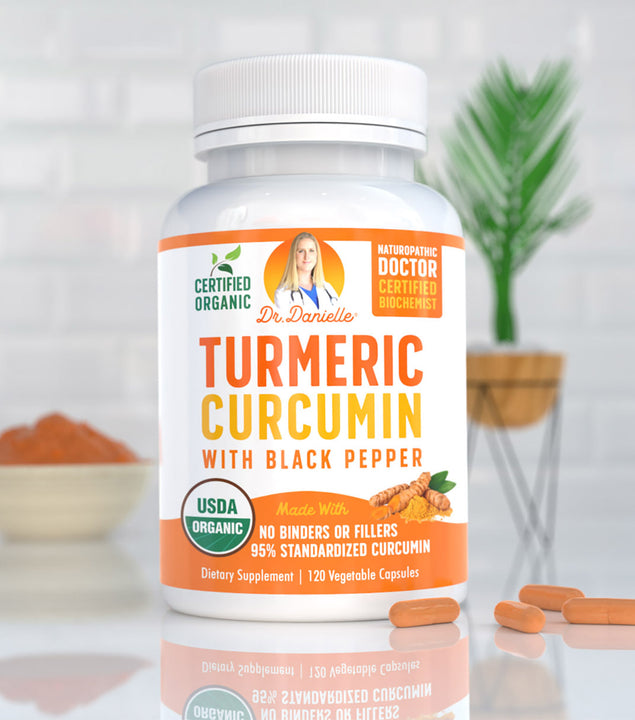You have eczema. Angry, red rashes cover your body, from the back of your neck to elbow creases to legs, in an onslaught of itchy misery. While scratching offers temporary relief, it leads to a vicious "itch-scratch" cycle: scratching worsens eczema, causing more scratching, leaving your skin scaly and oozing. Between the intense itching, peeling, and crusting, eczema can seriously affect your mental health. More than one-third of individuals with eczema say they "often" or "always" feel embarrassed or angry by their appearance due to the condition (1).
More worrying still, research shows that individuals with eczema are up to 44% more likely to exhibit suicidal ideation, and 35% are more likely to attempt suicide (2, 3, 4, 5). All this begs one question. How can you better control flare-ups without over reliance on topical steroids or antibiotics? Below, find 7 lifestyle and diet hacks that may help you feel like yourself again.
#1: Figure out your triggers
One way to minimize the need for medication is to prevent flare-ups from occurring in the first place. And the key to that lies in figuring out your personal eczema triggers. Common “culprits” include sweating, exposure to extremely dry air (e.g., during winter), or irritants like dish soap, laundry detergent, or metals like nickel (6, 7). You should also be on the lookout for allergens like pet dander, dust mites, molds, and pollen.
Once you've identified your personal trigger, develop an action plan to avoid—or significantly reduce—your exposure to it. So, let's say laundry detergent is a problem for you. What you could do is wear gloves whenever handling it or switch out your current detergent for one that's labeled "fragrance-free" (note: fragrances are known to cause skin reactions in individuals with eczema) (8).
#2: Give “eczema diet” a go
Given all the redness you see with eczema, it shouldn’t be a surprise to learn that the condition is characterized by inflammation (9). So now, think about it: what's one way you could lower inflammation levels in your body? That’s right. Your diet (i.e., the foods you eat). In general, research shows that you may better control eczema by consuming more anti-inflammatory foods like antioxidant-rich tomatoes, green leafy vegetables (e.g., spinach, kale, and collards), nuts (e.g., almonds and walnuts), and fatty fish (e.g., salmon, mackerel, and tuna) (10). Oh, and, of course, who can forget about Dr. Danielle’s Turmeric Curcumin when talking about antioxidants (11, 12)?
You may also wish to turn to other supplements; according to this 2017 study published in the Journal of Dermatological Treatment, individuals with eczema reported that they saw the most improvements in their condition when they took these supplements: omega-3 fatty acids, vitamin D, vitamin C, and zinc (13). Psst: find vitamin D, vitamin C, and zinc in Dr. Danielle’s Elderberry Immune Assist and D3 + B12 Gummies.
#3: Dunk yourself in bleach
Um, wait, what? Bleach? As it turns out, 90% of individuals dealing with chronic eczema—unlike those who’re not—carry a bacteria called “Staphylococcus aureus” on the skin (14). This causes red, painful, raised bumps.
If that sounds like what you're struggling with, then a bleach bath may be just what you need. And yes, the bleach needs to be diluted: place one-quarter to one-half cup of bleach in a full bathtub of water, then soak away for 5 to 10 minutes. Do this twice a week, and you’ll likely see a reduction in itching, redness, and scaling (15).
#4: Bathe frequently
Have you ever gotten advice that bathing too much is bad for your skin? Yeah, well, that advice is outdated. Dermatologists now encourage individuals with eczema to bathe with lukewarm water (which helps minimize skin irritation) at least once a day (16). Beyond cleaning off bacteria, frequent bathing also helps rehydrate your parched epidermis—no thanks to all the cracking and peeling it does.
That said, it's true that water evaporating off your skin after a bath dries it out by increasing trans-epidermal water loss, where water from the deeper layers of skin passes through the epidermis and into the air (17). This, in turn, links to the next tip.
#5: Moisturize, moisturize, moisturize
To counter excessive trans-epidermal water loss, you’ll have to moisturize. Research agrees; studies show that any kind of moisturization minimizes flare-ups and reduces the need for prescription medications (18). For best results, though, your first choice should always be an ointment—these typically contain petroleum jelly, which helps create an occlusive, protective barrier enabling your skin to retain moisture and heal (19). Petroleum jelly is also hypoallergenic, anti-inflammatory, anti-bacterial, and anti-fungal, making it an all-around star in preventing and managing eczema.
Can’t stand how greasy petroleum jelly feels on your skin? Viable alternatives include creams with glycyrrhetinic acid, urea, glycerol, or oats. Other natural moisturizers possibly already available in your kitchen include aloe vera and apple cider vinegar (20, 21).
#6: Try wet wrap therapy
Does your skin still feel tight, dry, and parched—no matter how many layers of moisturizer you slather on? Then, it may be time to try wet wrap therapy. It's basically what it sounds like: the treatment involves wrapping troubled, moisturized areas of skin with a damp fabric, either for a couple of hours during the day or overnight. As unorthodox as the therapy may sound, it has received endorsements from countless dermatologists and individuals with eczema (who say it’s changed their lives for the better). The National Eczema Association, for example, states that wet wrap therapy could help rehydrate the skin and make medications (if any) soak in more effectively (22). The damp fabric can also serve as a physical barrier, preventing you from scratching the affected areas.
While wet wrap therapy sounds straightforward, there are a few things you need to be mindful of. First, the fabric you use for the wet layer should be something tight-fitting (e.g., a thermal layer) so it doesn't slip right off you as you toss and turn. Next, your clothes should be slightly damp—instead of soaking wet. And finally, to prevent you from shivering through the therapy, add a dry layer (e.g., sweats or loose-fitting pajamas) on top of the wet layer. Blankets straight out of the dryer could also provide extra warmth.
#7: Take care of your gut
Does your gut health affect your skin? It does. The truth is that your gut and skin hold a constant dialogue via something known as the “gut-skin axis” (23). A growing body of evidence now finds links between gut health and skin issues like eczema: studies show that where there is gut inflammation (due to an out-of-whack gut microbiome), there will be skin inflammation. So, what does this mean to you? It means that you need to do all you can to support gut health. And while it's not known what the "best" gut microbiome looks like for eczema prevention and management (yet), you can't go wrong with increasing diversity within your microbiome (24, 25, 26).
To that end, lifestyle choices you could make include eating a high-fiber diet, incorporating fermented foods (e.g., yogurt, kefir, tempeh, kimchi, and sauerkraut), limiting alcohol intake and managing stress (i.e., take Dr. Danielle’s Stress Lift if your anxiety levels are through the roof). You could also give the “good” bacteria in your gut a boost by supplementing with probiotics (e.g., Dr. Danielle’s Probiotics); research shows probiotics can be helpful for various skin disorders—including eczema (27).
It’s important to address leaky gut syndrome
Caring for your gut isn’t simply about increasing the amount of “good” gut bacteria you have, either. It’s also about reducing your intestinal barrier permeability. Or, in other words, alleviating leaky gut syndrome. See: when the lining of your intestine becomes more permeable, it allows undigested food particles, toxins, and other foreign invaders to escape the gut—and enter the bloodstream, causing a cascade of reactions leading to inflammation (28). And we all know what inflammation in the body worsens … yep, eczema.
So, how can you address leaky gut syndrome? Beyond cutting down on your consumption of inflammatory foods (e.g., processed, high-fat, high-sugar foods), increasing your intake of high-fiber foods, and taking probiotic supplements, you could also turn to Dr. Danielle’s Gut Assist. It’s specifically formulated to help your gut better defend itself against the daily attacks from stress, food particles, toxins, drugs, and pathogens—giving it the time it needs to heal.
Takeaway
As outlined in this article, the best way to manage eczema is by identifying—and reducing—your exposure to triggers, bathing and moisturizing frequently, eating an anti-inflammatory diet, trying out alternative therapies whenever necessary (e.g., bathing in diluted bleach and wet wrap therapy), and taking care of your gut health.
However, it's also important to seek additional help from medical professionals if you fail to see relief no matter what you do. A skin specialist, for instance, will be well-equipped with the required specialized knowledge to further tailor your treatment plan, so you can start feeling better sooner.









2 comments
My dermatologist took a biopsy of one of the “moles” and resulted in “prurigo nodularis” but for about 2 weeks, prescription creams and taking prescribed Xysal still leaves me itching intensely all over – any advice would be appreciated.
This article was incredibly helpful,
thank you Dr. Danielle!